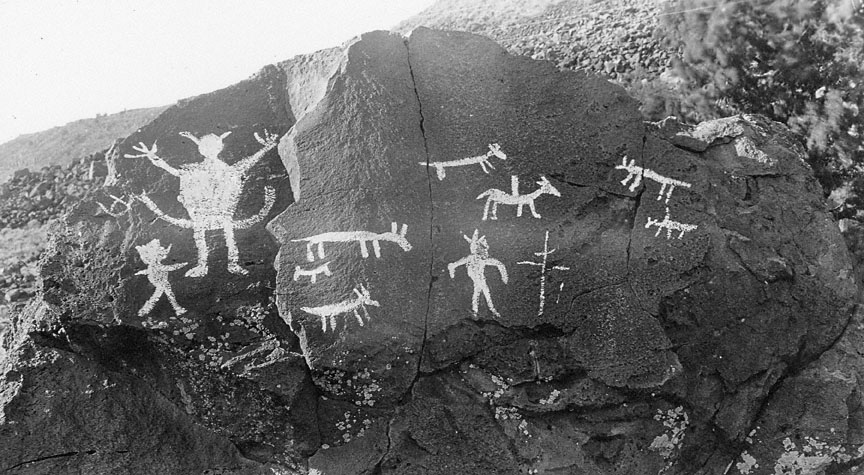This photograph, probably taken in the 1920s or 1930s, shows Indian rock art at Picture Rocks Pass, located in Lake County between Silver and Summer lakes. It is part of the Marshall Family collection of photographs.
Rock art, some of it tens of thousands of years old, can be found on all inhabited continents. Generally speaking, there are two forms of rock art, petroglyphs and pictographs. Petroglyphs are created by carving into the rock, while pictographs are created by painting the surface of a rock. The term rock art refers to both petroglyphs and pictographs.
Picture Rocks Pass is named after the petroglyphs shown in the photograph above. This photo shows anthropomorphs—human-like figures—and animal figures that have been chalked in order to increase the contrast for photographs. It should be noted that, although a common practice in the past, it is not appropriate to chalk petroglyphs in this manner. It is illegal to do so on public lands.
It is difficult to interpret rock art, but the large horned anthropomorph to the left of the photo may represent a spirit being, while the animal figures may represent dogs aiding a human figure towards the middle of the photo hunt a game animal. The central animal figure appears to have a rider, suggesting a mounted horse, but archaeologist Mary Ricks argues that it is probably a bighorn sheep, noting that “it appears that the vertical element which has been interpreted as a rider was added to the design sometime after the animal figure was created, since the vertical element and the quadruped show differing amounts of repatination.” Patination refers to dark stains that color exposed rock surfaces, particularly in warm arid areas. The degree of repatination of different petroglyph surfaces can be used to develop a relative dating scheme. Although some rock art in the Great Basin area has been dated to 8,000 years old, the age of most rock art cannot be determined with certainty.
Archaeologists have identified numerous functions of rock art. Robert Heizer and Martin Baumhoff argue that shamans created some Great Basin rock art along game trails as a kind of sympathetic magic to improve hunting success. Besides serving as hunting magic, Native peoples in the Pacific Northwest also created rock art during vision quests, as marks of territorial claims, as “doodles” to pass the time, as talismans against evil spirits, as markers of significant religious sites, and as records of important myths and historical events.
Further Reading:
Heizer, Robert F., and Martin A. Baumhoff. “Great Basin Petroglyphs and Prehistoric Game Trails.” Science 129, 1959: 904-905.
Keyser, James D. Indian Rock Art of the Columbia Plateau. Seattle, Wash., 1992.
Ricks, Mary F. “Rock Art and Human Settlement in the Fort Rock Region.” In Archaeological Researches in the Northern Great Basin: Fort Rock Archaeology Since Cressman. Eugene, Oreg., 1994.
Written by Cain Allen, © Oregon Historical Society, 2005.
